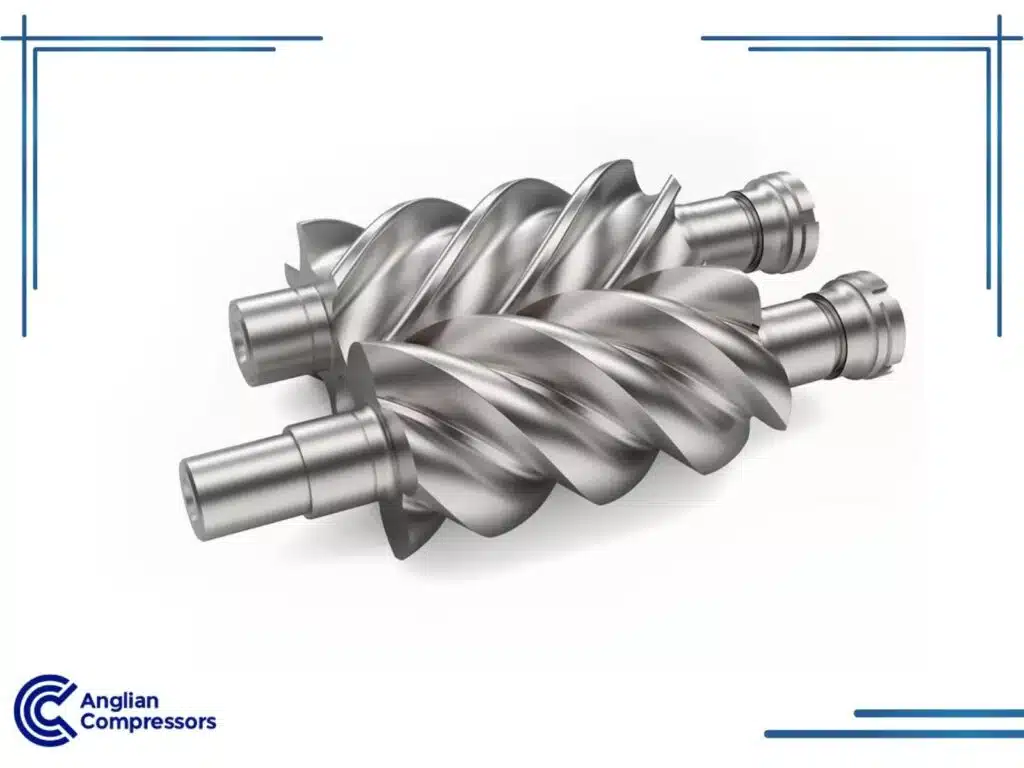Why Is the Air Compressor End (Air End/Element) More Vital than Other Components?
Air compressors use a range of quality components that work together to deliver compressed gas or air reliably and efficiently. But arguably, no component is more critical than the compressor’s air end, otherwise known as the compressor element or compressor stage.
But what exactly is an air end? What happens if it sustains damage or degrades? And can you replace or repair a faulty air end? In this blog, we will answer all those questions and more.
Do you need personalised advice based on your specific make and model of air compressor? Thanks to our decades of experience, industry-leading partnerships, exceptional customer service, and competitive prices, Anglian Compressors is your go-to resource for all questions and replacements related to air ends in the UK.
Anglian Compressors has been one of the UK’s leading air compression specialists and a premier distributor for Atlas Copco since 1977. We are licensed, insured, and certified to carry out repairs on all makes and models of Atlas Copco compressors, along with many other makes.
Our goal is to provide the best value, fastest turnaround times, and tailored advice to meet your specific needs. Contact us today to learn more about air ends and their importance.
Understanding the Air End
The air end is the heart of a rotary screw air compressor, responsible for compressing air efficiently. It consists of two interlocking rotors – one male and one female – supported by precision bearings. In oil-injected rotary screw compressors, oil is used for lubrication, cooling, and sealing, ensuring optimal efficiency and extending the life of the compressor.
On the other hand, oil-free air compressors rely on precision machining to deliver compressed air free from oil contamination, making them ideal for industries requiring high air quality.
As the air end is subject to wear, regular inspection of the air end and oil level is essential to prevent worn or damaged components from leading to higher energy consumption, excessive noise or vibration, or reduced pressure and flow rates.
Air leaks or damaged bearings can indicate a problem, affecting pressure and air volume. Additionally, air dryers and oil coolers help cool the compressed air and prevent contamination by ensuring the system runs smoothly.
A new air end or replacing worn components can extend the life of your compressor and compressed air system while reducing operational costs. Leading manufacturers, such as Atlas Copco, design air ends with high-efficiency rotor profiles to reduce the efficiency losses caused by worn components over time.
Choosing a quality compressor air end operates within the recommended parameters, maintaining optimal efficiency in applications requiring a consistent cubic feet per minute (CFM) flow of air.
Why Is the Air End so Vital?
The air end is the central component of air compressors. It uses two rotors that fit together – a male and a female rotor. In rotary screw machines, air passes between these rotors and gets compressed to deliver the steady flow needed for workshop tasks.
Oil-injected compressors use oil during the compression process for cooling, lubrication, and creating a seal. After running for 8,000–10,000 hours, the air end begins to wear, reducing precision and efficiency. As parts wear down, air leaks during compression, making the motor work harder to maintain output. This uses more electricity and stresses other components.
If you ignore air end maintenance, your compressor will not last as long. Sometimes rebuilds are necessary, but regular servicing often extends working life considerably.
The air end directly affects both performance and energy bills. Keeping it well-maintained is practical and cost-effective for long-term reliability. Many local workshops arrange maintenance during bank holidays or slower periods to avoid disrupting daily work.
Causes of Air End Deterioration
As with any mechanical component, the performance of your air end deteriorates over time. This process is accelerated in harsh environments with high temperatures, dust, or humidity.
Key causes of air end deterioration include:
- Rounding of screw rotor geometrics.
- Damaged coatings.
- Increased or uneven tolerances, forcing the compressor to work harder.
As the air end degrades, your compressor will consume more energy, leading to higher costs and a greater risk of damage to other components.
Air End Repair Options
When your compressor loses efficiency or makes unusual noises, the air end may be the cause. Though replacement might seem necessary, many issues can be fixed through repair – saving money and extending compressor life.
Air end repairs typically include:
- Replacing worn bearings, gaskets, and seals
- Rebalancing or regrinding rotors
- Refurbishing the lubrication system
- Testing to ensure proper output
In oil-injected screw compressors, wear leads to internal leakage and wastes energy. Regular servicing restores performance and prevents the need for major work.
At Anglian Compressors, we check each unit’s age, hours run and service history before recommending the best course of action. Our workshop in Norfolk handles most repairs within three working days, though bearing replacements often take a day longer due to curing times for the adhesives. We schedule most maintenance work during winter when demand is lower for our agricultural clients.
Can an Air End Be Repaired?
The air end consists of two interlocking rotors – one male and one female – which compress air through positive displacement compression. If wear or air pockets form between the rotors, the efficiency of the air end drops, causing the machine to work harder to maintain output. Inspecting the air end for lobe deterioration, worn bearings, and cooling system failures is crucial to determine whether repairs are feasible.
Repairs typically involve:
- Replacing worn components such as bearings, gaskets, and seals
- Rebalancing rotors and bearings to prevent vibration and misalignment
- Cleaning or replacing lubrication systems to avoid contamination
While minor wear can often be addressed, severe degradation can cause serious issues, making refurbishment or replacement the better option.
When to Refurbish Instead of Replace
Refurbishment can be a cost effective alternative if the air end requires restoration but is structurally sound. This process involves precision machining, recalibration, and sealing system upgrades to restore the lifespan of your compressor. Atlas Copco’s refurbishment programs can extend equipment life while improving energy efficiency.
When Replacement is the Best Option
If wear has progressed to the point where repairs or refurbishment cannot ensure reliable performance, a new air end may be the best option. Atlas Copco Element Xchange provides OEM-certified air ends designed to maintain the high pressure, airflow, and efficiency required by air compressors used in various applications.

Replacing a Damaged Air End
Replacing a damaged air end is often more cost-effective than purchasing a new compressor. Many manufacturers, including Atlas Copco, offer replacement programs like the Element Xchange, allowing you to replace your air end with a certified component.
Advantages of programs like Element Xchange include:
- Restoring your compressor’s original performance.
- Optional upgrades for improved efficiency and reliability.
- Guaranteed compatibility with existing components, avoiding issues common with generic parts.
As an authorised Atlas Copco distributor, we can facilitate air end replacements quickly and professionally, ensuring minimal downtime for your operations. Reach out to us for more information.
Thanks to the Atlas Copco Element Xchange program, you can replace your damaged air end with a new one that is correctly sized and 100% compatible with the rest of your compressor’s components. Generically sourced air ends may appear cheaper, but poor performance and reliability can quickly become issues if the generic component does not match the original.
Reach out to us if you want to learn more about the Atlas Copco Element Xchange program. As a premier distributor for Atlas Copco, we can do all the hard work on your behalf and we guarantee fast turnaround times.
Additionally, if you have an extended warranty type service contract with Anglian Compressors, and the air end should need replacing, this will be done, professionally, as part of the overall works.
Is Refurbishing an Option?
For damaged or worn oil-injected rotary screw air ends, refurbishing is a viable alternative to replacement.
Refurbishing involves:
- Restoring the air end to original factory specifications.
- Applying rigorous quality control standards.
- Ensuring reliability and energy efficiency comparable to a new air end.
At our dedicated refurbishing center, we offer competitive pricing and fast turnaround times, minimising the impact on your operations.
Do You Need an Air End Repair or Replacement?
The air end is the most critical component of your air compressor, and keeping it in top condition is vital for maintaining performance and efficiency.
Signs that your air end may need repair or replacement include:
- Increased energy costs.
- Reduced air output or inconsistent performance.
- Visible wear or damage.
For personalised advice and expert support, contact Anglian Compressors today. With nearly five decades of experience, we are proud to serve as a trusted partner for businesses across the UK.
FAQ
What causes the air end in an air compressor to deteriorate?
The air end wears down mainly through daily use. The rotors gradually lose their precise edges in oil-lubricated compressors after thousands of running hours.
Can I replace the air end of my compressor without buying a new compressor?
Yes, you can. Most suppliers stock replacement air ends for common models.Some workshops keep a spare unit on the shelf for quick changeovers during busy periods.
What is the difference between an oil-free screw compressor and an oil-flooded rotary screw compressor?
Oil-free compressors run without oil in the compression chamber. The air never touches oil, making them suitable for food packaging and pharmaceutical work. Thompson’s Bakery in Halifax uses these machines to avoid any risk of contamination.
Oil-flooded compressors mix oil with the air during compression. The oil lubricates the rotors and helps with cooling. The system then separates the oil before the air leaves the machine. These tend to be quieter and cost less to maintain.


